Are you looking for an ADAT audio interface to expand your inputs and outputs for large recording sessions?
ADAT is a type of connection that allows you to transfer up to eight channels of digital audio data between interfaces.
This connection protocol uses a digital optical audio cable to transmit audio data as pulses of light between devices, resulting in a high-quality, low-latency audio signal that is resistant to interference and noise.
Most importantly, by connecting two ADAT interfaces, you can significantly increase the number of inputs and outputs (I/O) available for recording and playback.
This connection type is especially useful for recording large ensembles, drum sets, and other applications where you need to capture several sound sources simultaneously.
In this article, we’ll look at some of the best ADAT audio interfaces on the market and help you choose the right one for your needs.
Overview: The Best ADAT Audio Interfaces
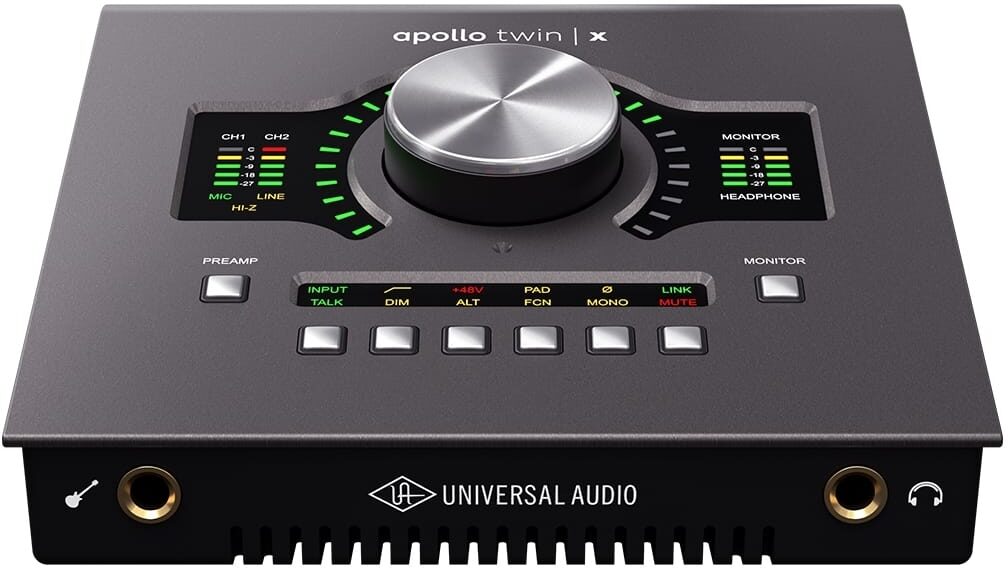
Universal Audio Apollo Twin
Universal Audio's Apollo Twin features top-quality mic preamps, 24-bit/192kHz digital audio converters, and various advanced controls to enhance your recording sessions - such as LED level meters, a Talkback button, a high-pass filter button, and more. It also includes onboard DSP UAD plugins and Unison-enabled preamps that don't increase latency or CPU usage when enabled.
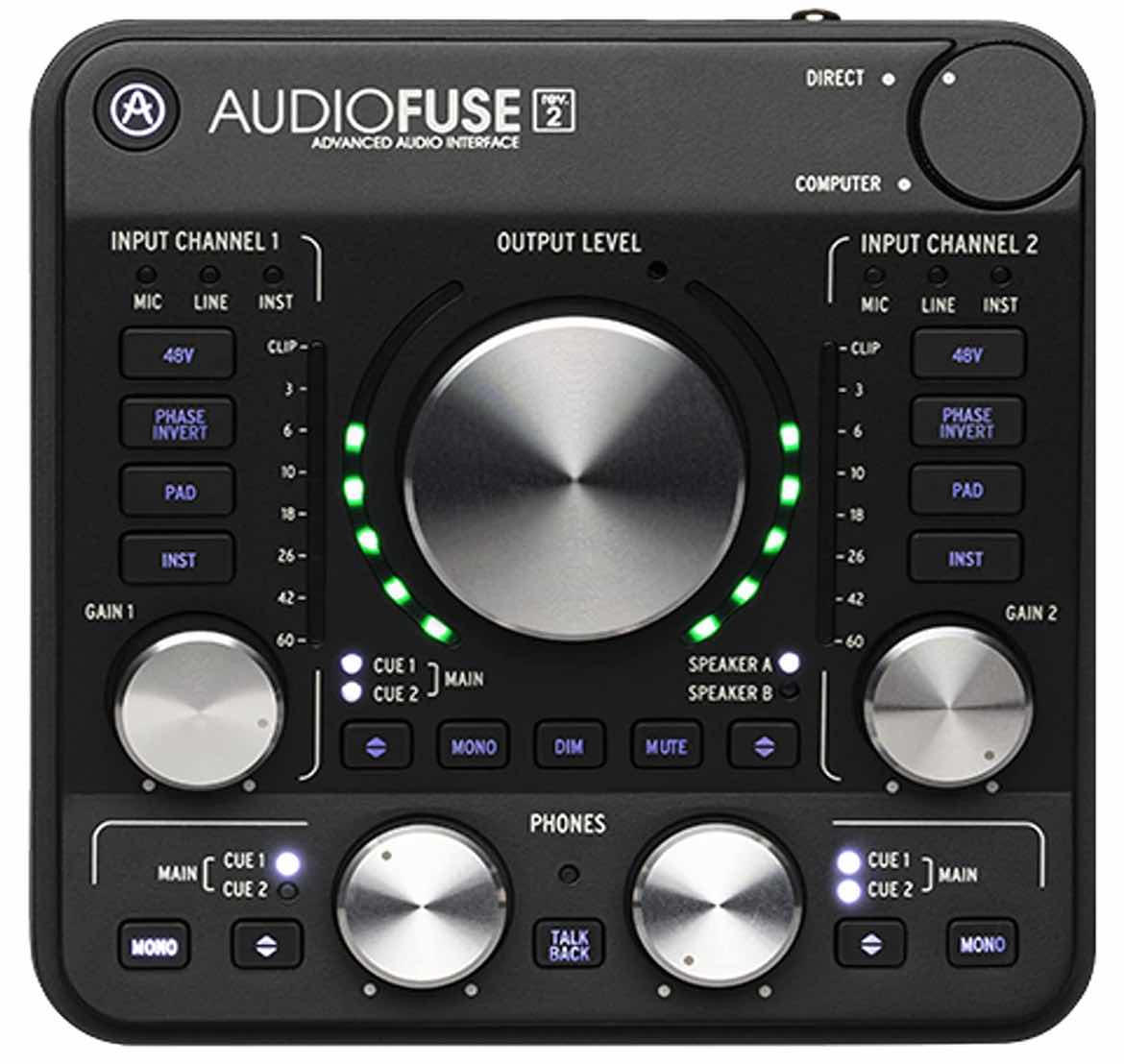
Arturia AudioFuse Rev 2
Arturia's AudioFuse Rev2 is a high-quality USB interface with professional-grade features like LED level meters, a Talkback button, and advanced speaker controls. It also offers two mic/line/instrument inputs, four-line outputs, MIDI I/O, and ADAT and SPDIF I/O allowing it to host up to fourteen inputs and outputs each.
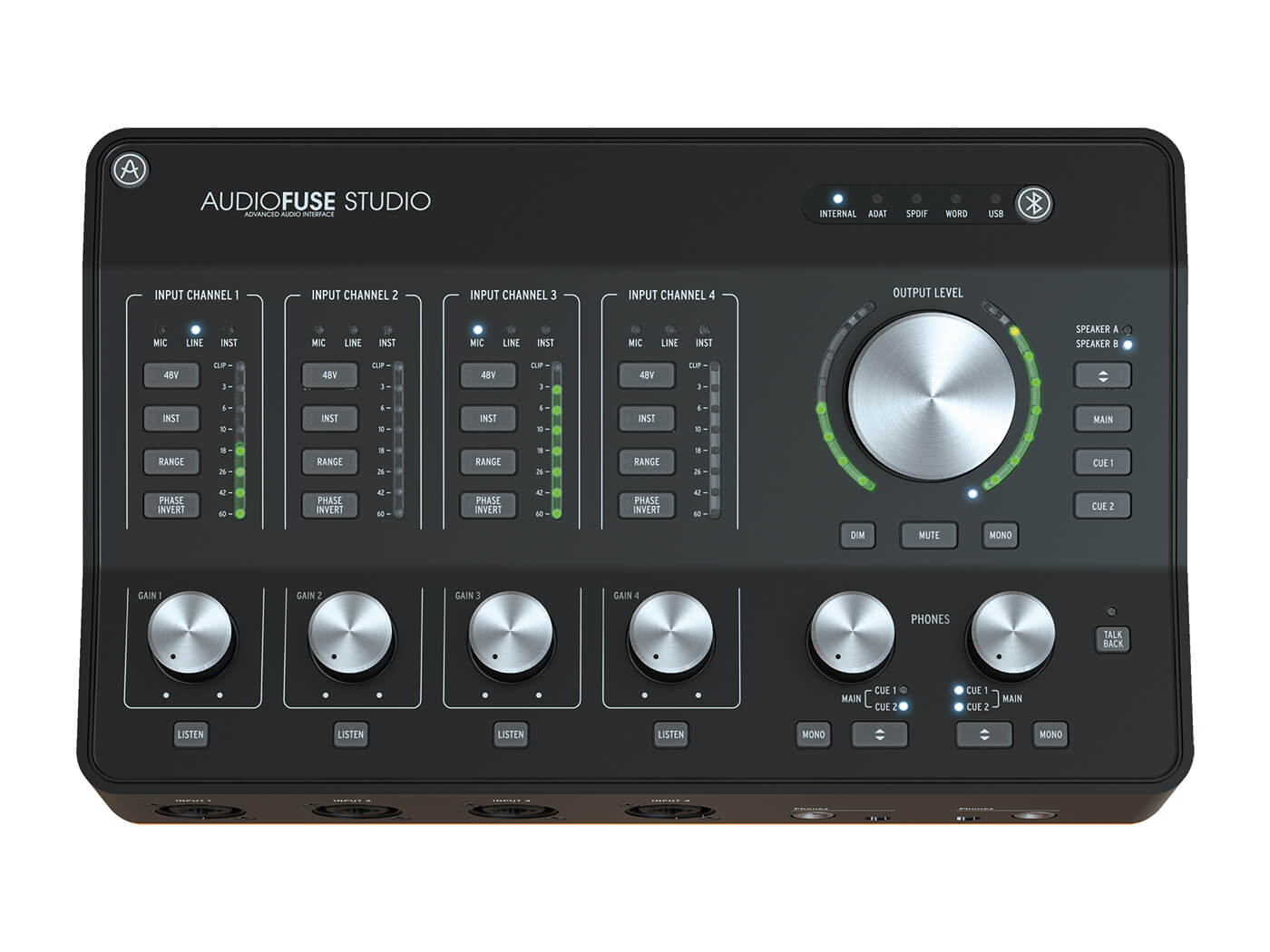
Arturia AudioFuse Studio
We recommend the Arturia AudioFuse Studio for those who need more inputs and outputs than the AudioFuse Rev 2 as it has two additional mic inputs. Both units have high-quality mic preamps with high gain and low preamp noise. They also have high dynamic range inputs and outputs
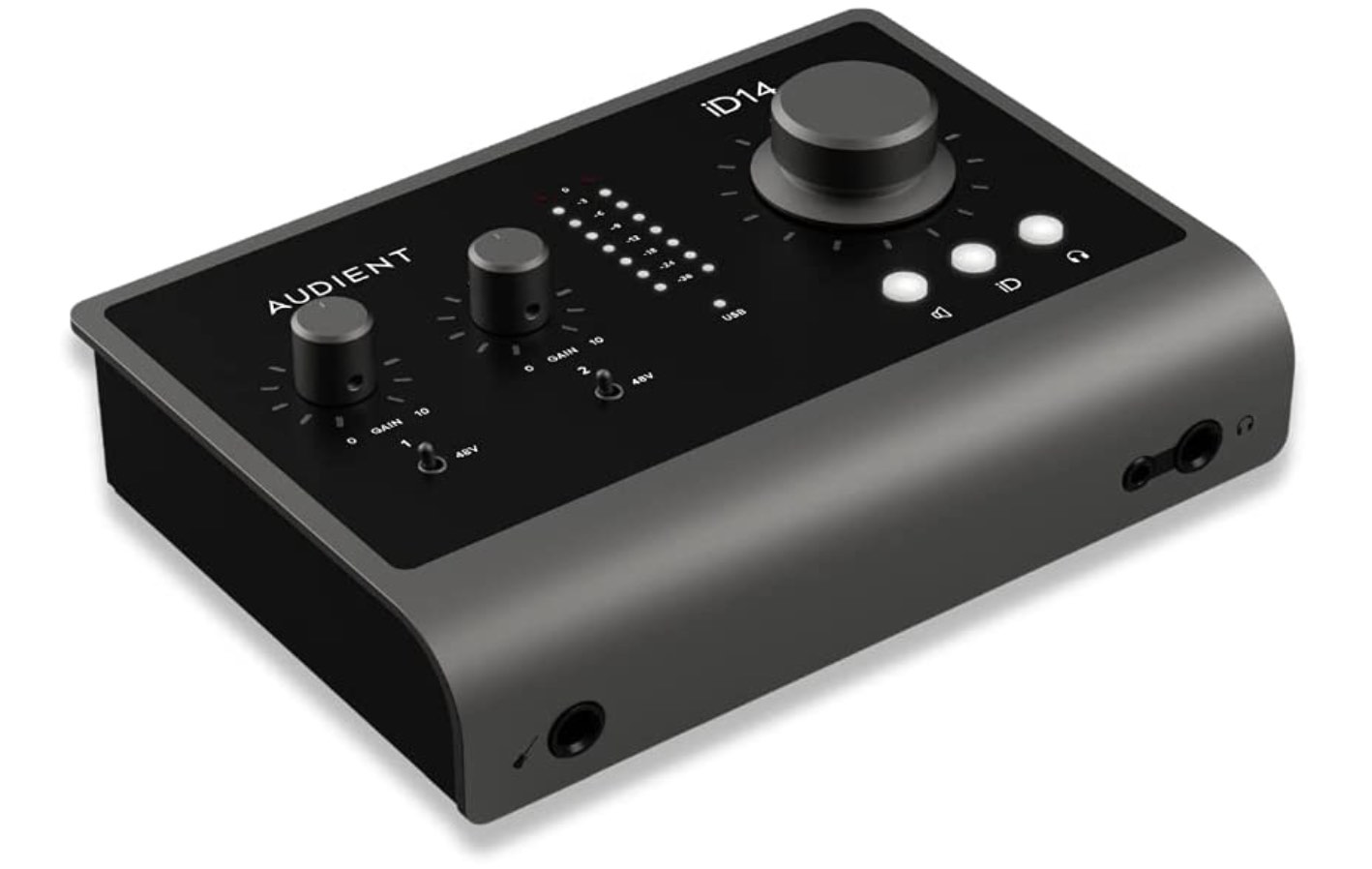
Audient iD14
The Audient iD14 is a portable and affordable option that delivers excellent sound quality, with two mic/line inputs, a JFET DI instrument input, four balanced outputs, and two headphone outs. It also features a multifunctional volume knob that you can use to control parameters in your DAW.
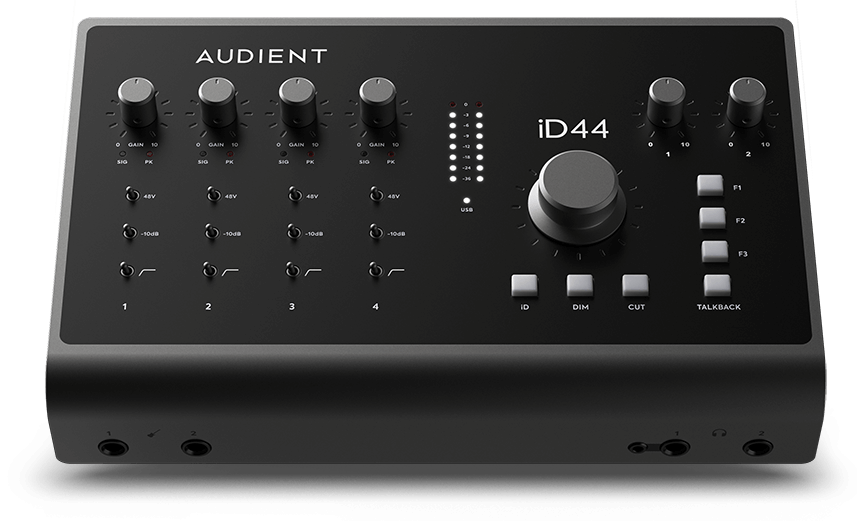
Audient iD44
The iD44 audio interface is an ideal choice for home studio recording with easy-to-use controls for features such as adding a high-pass filter, reducing input gain, enabling phantom power, and more. Additionally, the interface includes programmable "F" buttons to control advanced monitoring features like Polarity Reverse, Speaker Select, and Mono Sum.
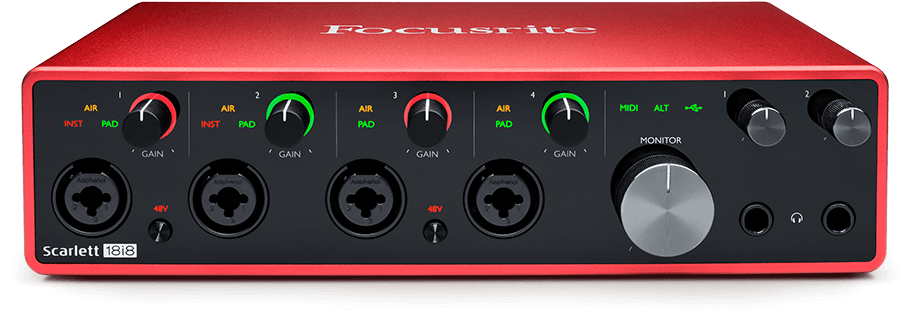
Focusrite Scarlett 18i8
The Focusrite Scarlett 18i8 audio interface is a well-built and easy to use option with excellent sound quality and Air Mode. It has eight analog inputs and four line outputs, along with MIDI, ADAT, and SPDIF connections. It also has two headphone outs with corresponding volume controls.

PreSonus Studio 1810c
The PreSonus Studio 1810c audio interface is an affordable and high-quality option with eight analog inputs and six outputs, as well as the option to add two, four, or eight ADAT channels at varying sample rates. It's an excellent choice for those who need up to eighteen inputs.

Behringer UMC1820
The Behringer UMC1820 is a USB-C audio interface with 18 in x 20 out capability, offering eight analog inputs, two main outputs, and four sets of line-outs.

Focusrite Scarlett 18i20
The Focusrite Scarlett 18i20 audio interface is similar to the Scarlett 18i8 in terms of audio quality and Air mode but provides ten line outputs, eight mic inputs, and the ability to expand inputs to eighteen and outputs to twenty using ADAT and SPDIF Ins and Outs.

PreSonus Studio 1824c
The PreSonus Studio 1824c audio interface has the same design and sound quality as the 1810c but offers 20 outputs, eight analog mic inputs, and an ADAT output, making it an excellent choice for those who need multiple output options at an affordable price.
How to Choose the Right ADAT Audio Interface
When choosing an audio interface, there are a few things to keep in mind.
First, you’ll want to ensure that it has enough inputs and outputs for your recording needs.
Another important consideration is its converter and preamp quality.
An audio interface with high-quality converters and preamps will produce audio that closely represents your original sound source.
Conversely, lower-quality converters and preamps can degrade the clarity of your audio.
They may add unwanted noise, distortion, and coloration to your audio signals, resulting in a less accurate representation of your sound source.
Finally, it’s best to consider whether you want an interface with USB or Thunderbolt connection.
USB is more common, but Thunderbolt is faster and provides lower latency.
Thunderbolt’s speed and reliability make it the preferred option for higher-end interfaces.
With these considerations in mind, here’s our list of the top 10 ADAT audio interfaces to help you narrow down your search.
If you’re unfamiliar with ADAT, later in this article, we’ll explain what it is and how to use it to add more I/O to your recording setup.
The Top 10 Audio Interfaces with ADAT
Benefits
– Onboard DSP UAD plugins
– Unison-enabled preamps
– Top quality converters and preamps
– LED level meters with clipping indicators
Drawbacks
– Pricey
– Only 2 physical mic inputs
– Doesn’t have an ADAT output
The Universal Audio Apollo Twin is one of the most popular high-end audio interfaces.
It features two high-gain, low-noise mic preamps, 24-bit/192kHz converters, and built-in UAD plugins – digital emulations of Universal Audio’s legendary analog recording hardware.
Onboard Controls
With its advanced features and premium sound quality, the Apollo Twin is an excellent choice for any musician or producer looking to take their recording studio to the next level.
You’ll get advanced controls like a Talkback button that makes it easier to communicate with a vocalist in another room.
There’s also a high-pass filter button allowing you to cut out unwanted low frequencies.
Additionally, the Apollo Twin X includes dedicated monitor controls, allowing you to easily switch between multiple sets of speakers and adjust their volumes.
DSP Plugins and Unison-Enabled Preamps
What makes the Twin X stand out compared to other interfaces on this list is its built-in digital signal processing (DSP) plugins and Unison-enabled preamps.
These plugins are digital emulations of UA’s classic analog gear, most notably it’s LA-2A and 1176 Compressors.
You’ll get a selection of highly-sought after EQ, compressor, reverb, and guitar amp plugins.
This model also has Unison-enabled preamps.
In the included software control panel, you can switch your mic preamps between vintage and tube preamp emulations from Neve, API, Helios, UA, and more, at any time.
The great thing about using onboard DSP plug-ins and Unison preamps is you won’t introduce latency to your performance – as opposed to adding plugins through your DAW while recording.
2. Arturia AudioFuse Rev 2
Benefits
– Advanced studio controls to streamline recording
– User-friendly design
– Excellent converters and preamps
– LED level meters with clipping indicators
– Comes with an ADAT In and Out
Drawbacks
– Only 2 physical mic inputs
If you’re looking for a high-quality, professional-grade USB interface, the Arturia AudioFuse Rev2 is also one to consider.
It offers several features for a professional home recording studio – such as a Talk-back button, LED level meters, advanced speaker controls, pad and reverse polarity buttons, etc.
With its two mic/line/instrument inputs, four-line outputs, and MIDI I/O, you’ll have plenty of ins and outs to work with for a basic setup.
Plus, if you need additional channels the AudioFuse comes with separate ADAT and SPDIF ins and outs to expand your inputs and outputs to fourteen each.
3. Arturia AudioFuse Studio
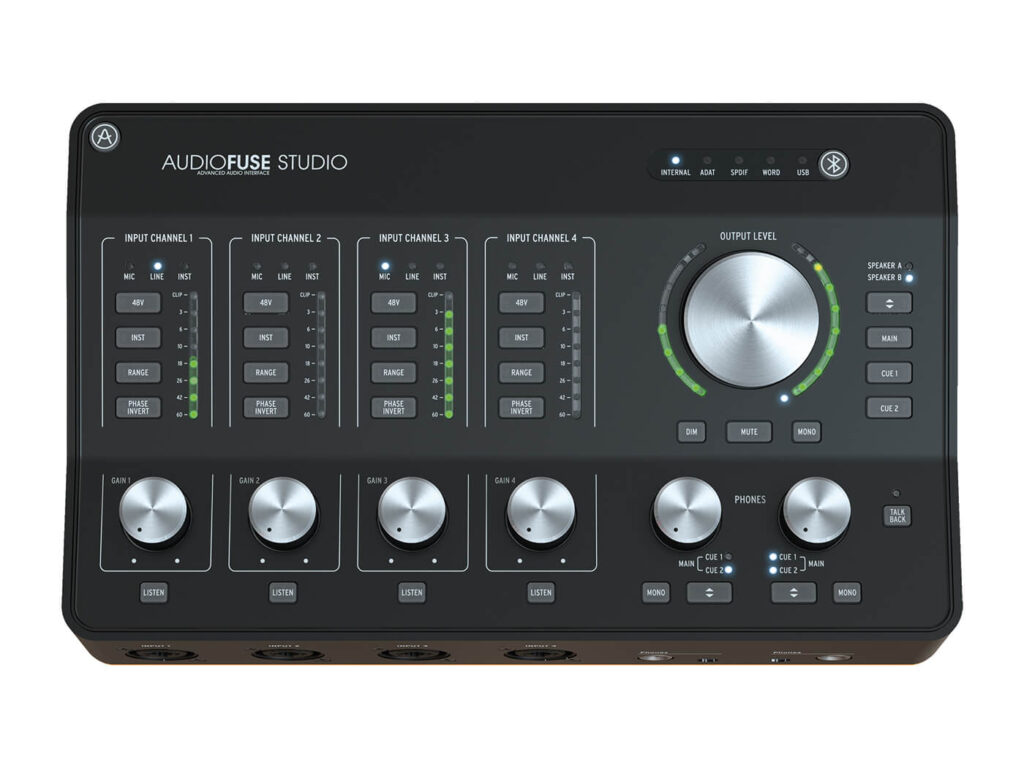
Benefits
– Advanced studio controls to streamline recording
– User-friendly design
– Excellent converters and preamps
– LED level meters with clipping indicators
– Comes with an ADAT In and Out
– Bluetooth receiver
Drawbacks
– Pricey
We recommend Arturia’s AudioFuse Studio if its AudioFuse Rev 2 doesn’t have enough inputs and outputs for you.
Both units offer best-in-class mic preamps with a wide gain range of 71 dB and low noise (EIN of -129 dBu).
They also have inputs and outputs with high dynamic range (over 115 dB).
The main difference between Arturia’s AudioFuse Studio and AudioFuse Rev 2 is that the AudioFuse Studio has two additional mic inputs.
4. Audient iD14
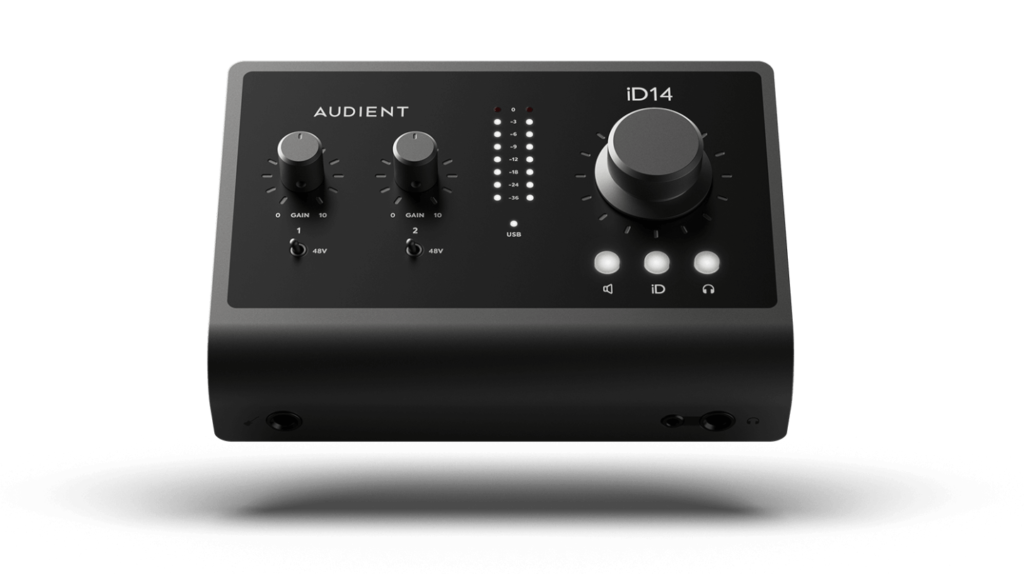
Benefits
– High-quality mic preamps
– Multifuctional ScrollControl
– Excellent converters and preamps
– Dedicated JFET DI input
– Clean, easy to navigate design
Drawbacks
– No MIDI I/O
– No ADAT output
– Only 2 physical mic inputs
– Doesn’t come with software or DSP plugins
If you’re a fan of Audient’s iD4 but need more inputs and outputs, consider its iD14 model.
The Audient iD14 is a portable 10-in, 6-out interface that helps produce excellent sound quality and offers advanced features – all at an affordable price.
It has two mic/line inputs – each with a mic preamp offering up to 56dB of gain.
There’s also a ¼-inch JFET DI instrument input for recording electric guitars, basses, and other high-impedance instruments.
Plus, it comes with four balanced outputs and two headphone outs.
What’s unique about the iD14 is that its volume knob is multifunctional. Besides controlling volume, you can use it to adjust parameters in your DAW such as volume, panning, and automation.
Like the other interfaces on this list, the iD14 comes with an ADAT optical input you can use to add up to eight additional digital audio inputs to your setup.
Its ability to host up to 10 inputs makes it a versatile choice for recording bands and podcasts. It can accommodate smaller recording sessions and expand when necessary.
5. Audient iD44
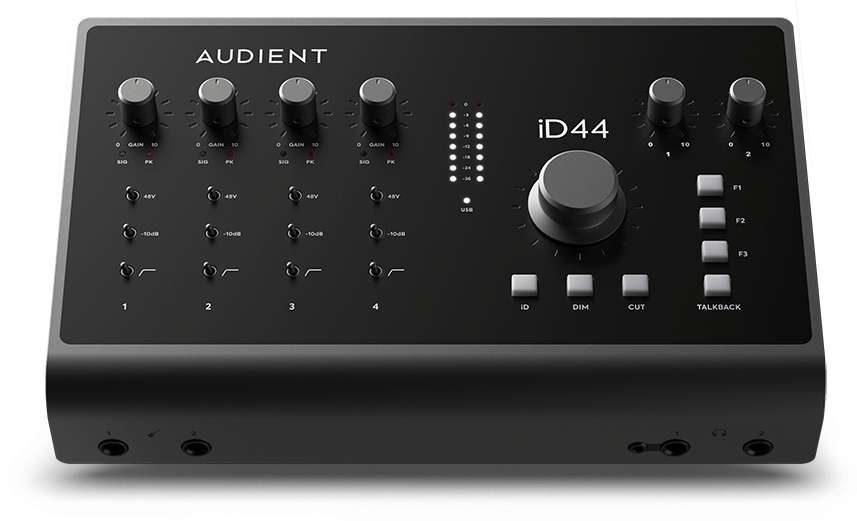
Benefits
– High-quality mic preamps
– Multifuctional ScrollControl
– Excellent converters and preamps
– Dedicated JFET DI input
– Clean, easy to navigate design
– Advanced onboard studio controls
Drawbacks
– No MIDI I/O
– Doesn’t come with software or DSP plugins
The iD44 is a fantastic option if you’re aiming for a more professional feel in your home studio.
It features easily accessible controls that let you instantly add a high-pass filter, reduce your input gain by 10dB, enable phantom power for each mic input separately, and more.
Not to mention three programmable “F” buttons you use to control advanced monitoring features like Polarity Reverse, Speaker Select, Mono Sum, etc.
There’s also a Talkback button with a built-in microphone, allowing you to easily communicate with a performer in another room.
Thanks to its dual ADAT in and out connectors, this unit supports a whopping 20-in, 24-out configuration – with four of Audient’s clean console mic preamps.
Plus it features two JFET DIs, helping you capture a richer tone from your guitar and basses.
6. Focusrite Scarlett 18i8

Benefits
– Air Mode
– Pad feature
– Dual headphone outputs with volume controls
– Software bundle
– Easy to navigate design
Drawbacks
– No ADAT output
– No LED level meters
The Focusrite Scarlett 18i8 is worth considering if you’re looking for an audio interface with tube preamp capabilities.
It features Air Mode – modeled after Focusrite’s ISA mic preamps – which enhances high-end detail and clarity, giving your recordings a more spacious and natural sound.
In addition, the 18i8 provides up to 18 inputs and 8 outputs, including four combo XLR/¼-inch inputs, four ¼-inch line inputs, two headphone outputs, and two sets of ¼-inch monitor outputs.
This model also has an ADAT optical input, allowing you to add eight inputs to your setup.
Plus, it comes with a comprehensive software bundle, including Ableton Live Lite and Hitmaker Expansion plugins.
7. PreSonus Studio 1810c

Benefits
– High-quality XMAX-L mic preamps
– LED level meters
– Dual headphone outputs with volume controls
– Software bundle
Drawbacks
– No ADAT output
– Crammed gain knobs
The PreSonus Studio 1810c is an excellent option if you’re looking for an affordable, high-quality interface that supports up to eighteen inputs.
With eight analog inputs and six outputs, this unit produces excellent sound quality, thanks to its 24-bit/192kHz converters and crystal-clear X-MAX-L preamps.
You can also add up to 8 inputs digitally via ADAT, making it a great option for recording larger sessions or live performances.
The 1810c offers flexible connectivity. You’ll get a MIDI in and out, two headphone outputs, and a USB-C port for fast and stable data transfer.
Additionally, this model comes with PreSonus’ Studio One Artist DAW software. While it’s a simplified version of Studio One, it provides everything you need to get started with recording, mixing, and mastering your music.
Focusrite Scarlett 18i8 vs. PreSonus Studio 1810c
[Here’s a complete comparison between PreSonus and Focusrite audio interfaces]
8. Behringer U-Phoria UMC1820

Benefits
– 8 physical mic inputs
– 18 inputs and 20 outputs total
– Dual headphone outputs with volume controls
Drawbacks
– No level meters
– Max sample rate of 96kHz
Behringer’s UMC1820 is an 18 in x 20 out USB-C interface, giving you plenty of options for connecting mics, instruments, and other audio gear.
It has eight analog inputs with corresponding gain controls – plus two main outputs, and four sets of line-outs.
You can also add 8 inputs and 8 outputs via ADAT.
Layout and Controls
The UMC1820 comes with a MIDI in and out and two headphone outputs with corresponding level controls.
Each of its inputs has a gain control, a ¼-inch input toggle, a pad button, and an LED clipping and signal indicator.
Lastly, this model is USB-C powered but also comes with a 12V DC port.
PreSonus Studio 1810c vs. Behringer UMC1820
One thing you’ll notice on the Studio 1810c that you won’t find on the UMC1820 is a LED level screen.
Level meters are useful when you want a quick way to set your input gain and monitor clipping without referencing your DAW.
Out of all the entry-level interfaces I’ve used, PreSonus Studio interfaces have some of the most useful level meters.
Which One Should You Choose?
Both interfaces are some of the most affordable models you’ll find with up to 18 inputs.
They’re great for recording bands, drum sets, and larger recording sessions in general.
The main difference is the UMC 1820 has an ADAT output while the Studio 1810c doesn’t.
As a result, the UMC 1820 supports up to 20 outputs while the Studio 1810c can only 8.
We give the edge to the Studio 1810c in terms of sound quality. But if you’re looking to maximize your output options, the UMC 1820 is the better choice.
9. Focusrite Scarlett 18i20
Benefits
– 8 physical mic inputs
– 18 inputs and 20 outputs total
– Pad buttons
– Talkback button
– LED level meters
– Dual headphone outputs
Drawbacks
– No notable drawbacks
If you’re interested in Focusrite’s Scarlett 18i8 but need more outputs, check out its Scarlett 18i20.
You’ll get similar audio quality and the benefits of Air mode, but with 8 mic inputs instead of 4 – not to mention 10 line outputs.
You can also expand your inputs to 18 and outputs to 20 using its ADAT and SDPIF ins and outs.
10. PreSonus Studio 1824c
Benefits
– 8 physical mic inputs
– 18 inputs and 20 outputs total
– Dual headphone outputs
– LED level meters
Drawbacks
– No advanced controls/features
PreSonus’ Studio 1824c has the same design and sound quality as the 1810c but can support 20 outputs instead of 8.
It also offers 8 analog mic inputs, while the 1810c provides 4.
The only difference is the 1824c has an ADAT output which is why it can support 20 outputs.
If you’re a fan of PreSonus’ Studio interfaces and need a lot of I/O in an affordable unit, consider the 1824c.
ADAT Audio Interface Explained
ADAT, or the Alesis Digital Audio Tape, is a type of connection that allows for the transfer of digital audio signals between devices.
It’s a cost-effective way to expand the number of audio channels in your recording or live sound setup.
Using a device with an ADAT input and/or output allows you to add 8 channels at 44.1/48 kHz, 4 channels at 88/96 kHz, or 2 channels at 176/192 kHz.
To add channels to your setup, you’ll need another ADAT-compatible audio device.
You’ll also need an optical cable.
This type of cable uses light to transmit data, making it less susceptible to interference and noise than other types of cables.
How to Use Optical I/O on an Audio Interface
If you’re looking to expand your interface channels using ADAT, you may be wondering how to use an optical input and output.
Optical inputs are a great way to add audio channels to your recording setup.
Likewise, when using an optical output, you can send multiple channels of audio from your interface to external effects processors or speakers.
Optical outputs are useful when you need to route audio to multiple destinations in your studio or during a live performance.
To expand your I/O using ADAT, you’ll need two ADAT-compatible devices.
You can link your ADAT devices using an optical cable.
Then, you’ll need to synchronize their internal clocks and sample rate within their software control panels or your DAW.
Failing to do so can cause problems with audio quality, including dropped frames, clicks, and pops.
Takeaway: Finding the Best ADAT Audio Interfaces
An ADAT audio interface can provide you with additional channels and improved audio quality.
With the list of the 10 best ADAT audio interfaces presented in this blog post, you can choose the one that best fits your needs and budget.
Remember to consider factors such as compatibility with your computer, number of channels, and additional features such as digital signal processing.
Investing in a high-quality ADAT audio interface can take your recording studio to the next level.
With the right ADAT interface, you can reduce latency, improve your signal-to-noise ratio, and record cleaner audio.
So, take the time to research and compare the options presented in this list.
All these options offer unique features and capabilities, so it’s important to consider your specific needs and preferences.
By weighing the pros and cons of each option, you will feel confident that you’re investing in a high-quality interface that will serve you well for years to come.










